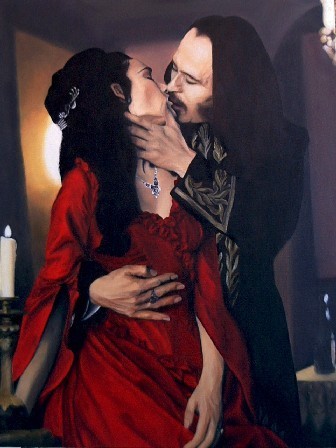Blog Post#2 Romance in the Context of Horror (Bram Stocker's Dracula)
In
Bram Stoker’s Dracula, Coppola incorporates elements of drama and romance to blur
the border between human and monster. In this sense, main protagonist (Dracula)
is not merely a metaphor for fear and horror but is given heroic and human
qualities to evoke sympathy in audience. Coppola has included many romantic and
erotic scenes, which illustrate different types of love among characters. He also
utilizes some elements of fantasy to preserve the context of horror and picture
desires repressed.
Through
the movie, Dracula expresses an endless but forbidden love toward Mina. Their
love story has a tragedy pattern same as the famous romantic novel “Romeo and
Juliet”. This similarity is apparent from the very first scene when finance of
Price Vlad (Dracula) decided to kill herself when she was informed her fiancé
is dead. In the relationship with Mina, Dracula shows more human qualities and
is more a lover in pursuit of only love of his life, Mina. Although he has the
chance to infect and attack Mina several time but he resist to harm her. This
completely in contract with his monstrosity and his demonic approach toward
Lucy.
Music,
actors’ facial expressions, and sexual interaction have contributed to romantic
aspect of the film. One substantially romantic scene in context of horror is
when he finds picture of Mina in Harker’s planner; his face suddenly shows an
innocence of devastated lover while his shadow is choking Harker and is a proof
of demonic and monstrous side of him. The set and evokes fear and sense of
insecurity while music and Dracula’s face induce the sadness of lost love which
surprisingly make audiences sympathy with monster (Dracula) than victim
(Harker).
The
climax of his love story with Mina is arguably last scenes of movie- sexual
interaction between Mina and Dracula- where Mina willingly drank Dracula’s
blood in order to become immortal despite of Dracula’s attempt to dissuade her.
And finally the very last scene where she decides do kill Dracula out of her
love. This scene is another scene where horror and romance are demonstrated
simultaneously. He has changed into the despised figure of otherness (elements
of horror) and provokes audiences’ sympathy toward monster by illustrating the
immortal tragic love story.
To
conclude, as Altman says" genre films must not only be similar in order to succeed, they must also be different". Through this movie Coppola introduced a new paradigm of horror genre which integrates Romance. Thus, audience are more entertained by palpable features and can relate more to horror and monster. Monster is not only representation of otherness and horror but it can be the heroic lover who can love like human (even better).
work cited
Altman,Rick. Film/Genre.London: BFI pub,1999.print.

No comments:
Post a Comment